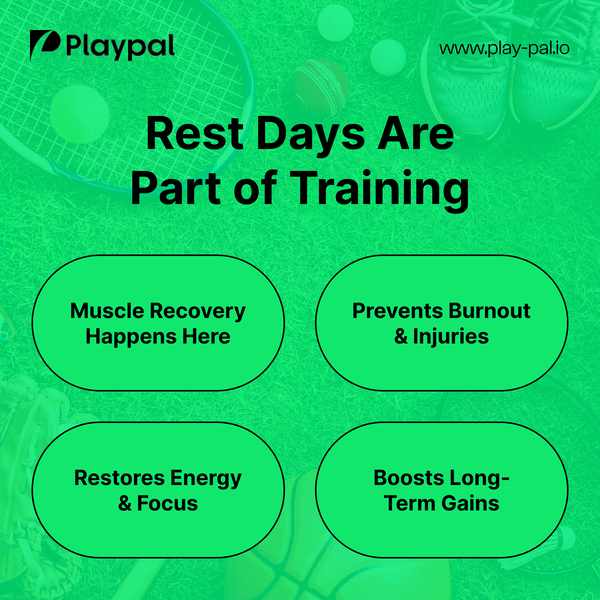In the world of sports and fitness, there's a pervasive myth that more is always better. Many athletes and fitness enthusiasts fall into the trap of thinking that progress is solely tied to how often or how hard they train. But the truth is, training without rest is like trying to build a house without ever letting the cement dry. Rest is not a sign of weakness—it’s a strategic component of any smart training plan.
In fact, rest days are not just beneficial; they are essential for long-term performance, injury prevention, and sustainable gains. Understanding how and why rest contributes to your overall fitness can help you train smarter and achieve more meaningful results.
Why Rest Days Matter in Every Training Program
Whether you’re a professional athlete, weekend warrior, or someone on a consistent fitness journey, rest days play a critical role in physical and mental recovery. Here’s why they matter:
1. Muscle Recovery and Growth
When you work out—especially during strength training—you create microscopic tears in your muscle fibers. These tears need time to repair. It’s during the rest period, not the workout itself, that muscles heal and grow stronger.
If you skip rest days, you rob your body of the time it needs to rebuild. Over time, this can lead to decreased performance, stalled progress, and increased risk of injury. A smart training routine is incomplete without scheduled recovery.
2. Prevention of Overtraining and Injuries
Overtraining is a serious risk for athletes who push themselves too hard without giving their body adequate time to recover. It can lead to chronic fatigue, muscle soreness, sleep disturbances, irritability, and even mental burnout.
Rest days allow the body to recharge and repair, reducing the risk of common injuries such as strains, sprains, and stress fractures. By balancing intense training with proper rest, athletes maintain better joint health, tendon flexibility, and overall physical resilience.
3. Restores Energy Stores
High-intensity training depletes your body’s glycogen stores, which are needed for energy. Rest allows these energy reserves to be replenished. Without adequate recovery, your body may not have the fuel it needs to perform at your best.
This is especially important for endurance athletes or those who train frequently. A well-planned rest day can improve performance in subsequent sessions by allowing full energy restoration.
4. Improves Mental Focus and Motivation
Physical fatigue often goes hand in hand with mental fatigue. Continuous training without breaks can lead to mental burnout, reduced motivation, and poor focus. Taking rest days can help reset your mindset, reignite motivation, and improve your overall attitude toward training.
Athletes often return from rest days with a renewed sense of purpose and improved concentration, which can positively impact performance during training or competition.
Active Rest vs. Complete Rest
Rest doesn’t always mean complete inactivity. There are two primary types of rest:
1. Complete Rest Days
These are days when you take a full break from physical activity. They’re essential when you’re feeling sore, mentally exhausted, or when you’re in recovery from an intense training phase. Complete rest allows for full muscular and neurological recovery.
2. Active Rest Days
Also known as active recovery, these days involve light activity such as walking, swimming, cycling, yoga, or stretching. The goal is to stimulate blood flow, loosen up muscles, and promote recovery without adding strain. Active rest is especially effective when planned between heavy training sessions.
Smart training routines integrate both types of rest based on training intensity, fitness goals, and recovery needs.
How Often Should You Take Rest Days?
The frequency of rest days depends on multiple factors including your fitness level, training intensity, goals, and lifestyle. However, some general guidelines include:
-
Beginners: 2–3 rest days per week
-
Intermediate to Advanced Athletes: 1–2 rest days per week, or strategic deload weeks every 4–6 weeks
-
Endurance Athletes or High-Volume Trainers: Active rest days between hard sessions to maintain performance without overtraining
Ultimately, the best indicator is your body. If you experience persistent soreness, fatigue, declining performance, poor sleep, or a lack of motivation, it may be a sign you need more recovery.
The Science Behind Rest and Adaptation
Training creates stress on the body. Rest is the phase where adaptation happens. This is known as the supercompensation cycle. It follows four phases:
-
Training Load: The workout causes a temporary drop in performance due to fatigue.
-
Recovery: Your body begins repairing the damage.
-
Supercompensation: Your body overcompensates, becoming stronger and more efficient.
-
Return to Baseline or Decline: Without another training stimulus, the body returns to its normal state.
If you train again during recovery, without reaching supercompensation, performance can decline. Strategic rest ensures you hit the peak point of supercompensation for optimal gains.
What to Do on Your Rest Days
Instead of viewing rest days as “lost time,” treat them as an opportunity to support your body in different ways:
-
Hydrate: Proper hydration supports muscle recovery and joint health.
-
Stretch or Foam Roll: Gentle mobility exercises can ease soreness and enhance blood flow.
-
Get Adequate Sleep: Sleep is when your body performs most of its recovery work.
-
Fuel with Nutrients: Protein and anti-inflammatory foods support muscle repair and energy replenishment.
-
Practice Mindfulness: Meditation or deep breathing can help manage stress and improve mental recovery.
Rest days can also be a good time to check in on your goals, reassess your training progress, or simply enjoy other hobbies and responsibilities outside of training.
Common Misconceptions About Rest
“Rest Days Will Set Me Back”
Truth: Inconsistent training sets you back. Strategic rest improves performance and prevents burnout.
“I’ll Lose My Progress If I Don’t Train Every Day”
Truth: Muscle loss or deconditioning happens over weeks, not days. Missing one or two sessions won’t erase your gains.
“I’m Not Tired, So I Don’t Need Rest”
Truth: Fatigue is not always a reliable indicator. Overtraining symptoms often appear after it’s too late. Preventative rest is smarter.
Final Thoughts
In the pursuit of excellence, it’s easy to focus only on the grind—the early mornings, heavy lifts, intense sprints. But true athletic growth comes from understanding that rest is not a luxury—it’s a necessity. Training without rest is like planting a seed and never letting it grow.
By scheduling regular rest days, listening to your body, and prioritizing recovery as much as effort, you’ll find that your performance doesn’t plateau—it accelerates. Rest is where the transformation happens.
So the next time you feel tempted to skip a rest day, remember: progress doesn’t just happen when you're working—it happens when you’re recovering too.





Leave a reply